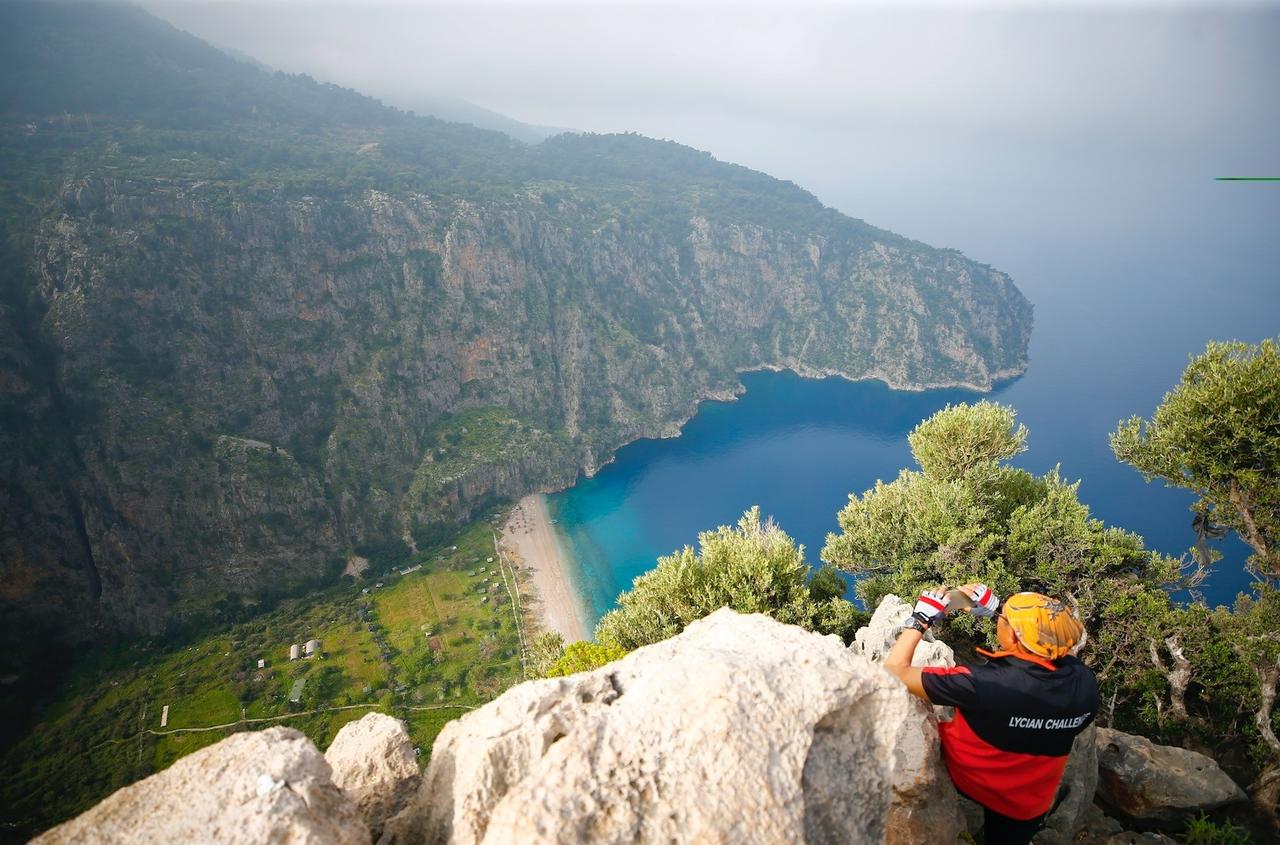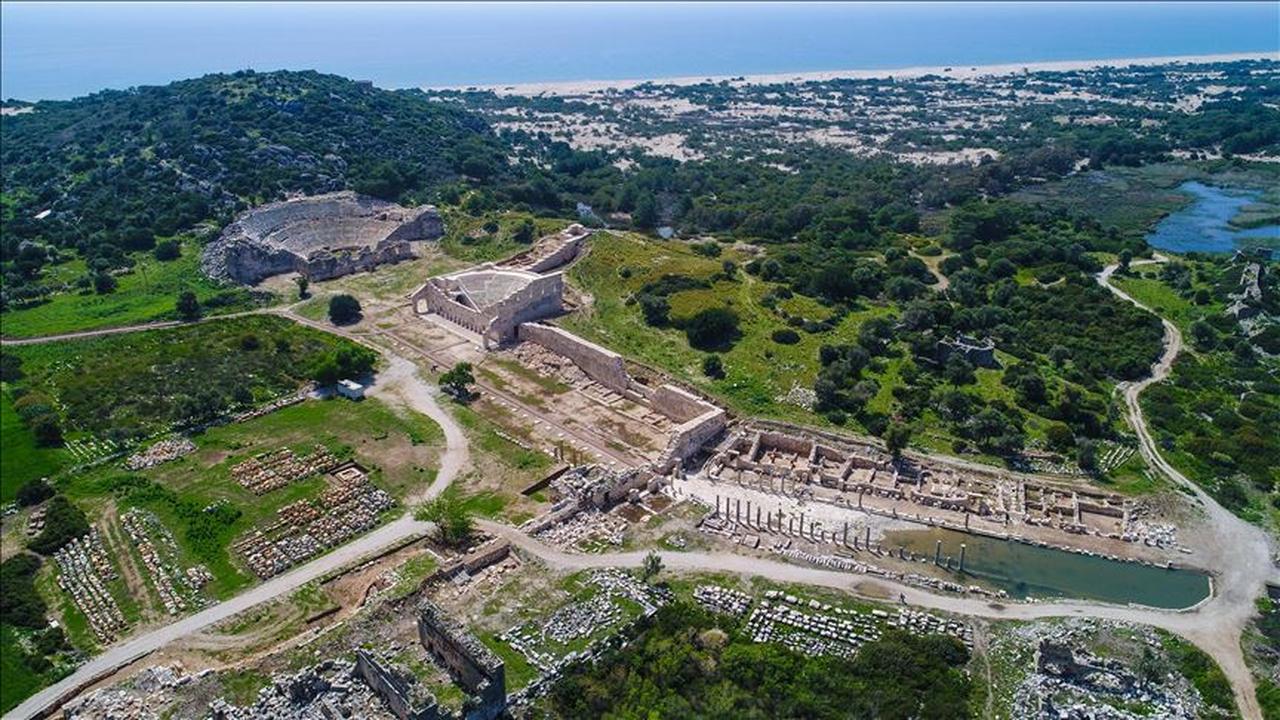
The Lycian Way is considered to be one of Türkiye’s most famous long-distance hiking trails, as it offers a mix of history, nature and adventure all at once.
The length of the trail is approximately 540 kilometers along the Mediterranean coast of southwestern Türkiye, from Fethiye to Antalya. It is waymarked with red and white stripes, respecting the GR footpath convention. This trip offers the opportunity to discover ancient Lycian cities, wander around mountain paths, enjoy quiet beaches, and witness charming rural villages.
Kate Clow, a British-Turkish writer and hiking enthusiast, discovered this trail in the 1990s and decided to share her treasure with the world. Her goal was to promote Türkiye’s beauty among foreign and local hikers and campers. In her pursuit to promote the trail, she mapped it in detail, marked it and published a whole guide of the hike that included all the needed details. Eventually, the Lycian Way became Türkiye’s first long-distance hiking trail and it then gained international recognition.
The Lycian Way is arguably a long distance to walk and therefore it is usually separated into sections, and on average, it takes a group of three people almost a month to hike from the starting point up until the last one. However, this journey is flexible and each person may choose to do it as they prefer, according to their preferences, time limitations and physical ability. Thus, many choose to hike just part of it. The following list contains some of the most important stages and checkpoints:

1. Fethiye to Faralya (Butterfly Valley)
Fethiye, a well-located coastal town, is the starting point of the trail. The early stage of the hike is remarkably interesting as it includes Oludeniz, known for its turquoise lagoon, and Butterfly Valley, a marvellous canyon that leads to a stunning beach. This stage can be a little steep for beginners as it includes uphill climbs, but the scenery makes it worth the trouble.
2. Faralya to Kabak and Alinca
This part passes through Kabak Beach, a beautiful and quiet bay that can be an alternative to the busier Oludeniz. Walking uphill will lead you to Alinca, where you can enjoy panoramic views over the coast.

3. Sidyma, Gey and Bel
If you want to experience the authentic Turkish culture and discover its history, this part of the trail dives into rural mountain villages and ancient ruins such as Sidyma, which is an old Lycian city with sarcophagi scattered in olive groves. Bel, on the other hand, is the perfect place to submerge yourself in Turkish hospitality.
4. Letoon, Xanthos and Patara
In this part, we will get back to the coast where major archaeological sites will welcome you, like Xanthos, a UNESCO World Heritage site, and Letoon, once a religious center. Next is Patara Beach—one of Türkiye’s longest and most unique sandy beaches—located beside the ancient ruins of Patara.
5. Kalkan to Kas
According to some hikers, this is the most scenic section, hugging the coastline and passing through hills, forests, and cliffside paths. Then you’ll arrive in the town of Kas—a perfect rest stop known for its cozy cafes, tranquil vibe, and relaxed atmosphere.
6. Aperlae, Simena, and Demre
At this stage, you will discover yet another historical wonder in Aperlae, where the sunken city of Simena is located, a city accessible only on foot or by boat. In Demre, don’t forget to take a look at the Church of St. Nicholas (the original Santa Claus) and the ruins of Myra.
7. Finike to Antalya
Last but not least is the final stretch, featuring remote mountain paths, pine forests, and ancient cities like Olympos and Phaselis, ending near Geyikbayiri—a renowned rock-climbing destination in Antalya.

The Lycian Way is really rewarding; however, it is also demanding. Thorough preparation is essential for a successful and enjoyable trip, especially if you plan to hike more than just a few sections.
Here’s what you need to consider before setting off:
Essential Gear
· Backpack (40–60 liters): Preferably lightweight with a hip belt for support.
· Good hiking footwear: Preferably waterproof and with good grip for rocky paths.
· Trekking poles: Useful on steep or uneven terrain and make it easier to walk further.
· Tent and sleeping bag: If you plan to camp (Not a must since pensions and guesthouses are available in many spots).
· Water bottles or hydration bladder: Carry at least 2–3 liters a day because water sources can be far apart.
· Sun protection: Hat, sunglasses, sunscreen (SPF 30+).
· First aid kit: Include blister care, antiseptic, painkillers, and personal medications.
· Headlamp or flashlight: For early starts or evening hikes.
· Map or GPS app: Even though the trail is marked, having navigation support, like maps.me or Gaia GPS, is wise.
· Power bank: Electricity isn’t guaranteed in all locations
· Turkish phrasebook or app: Locals are friendly, but not always fluent in English
· Best seasons: Spring (March–May) and Autumn (September–November) for mild weather and blooming landscapes.
· Training: Try walking longer distances or uphill hikes with a loaded backpack a few weeks before your trip.
· Permits: None required, but inform someone of your general route for safety.
· Accommodation: Book guesthouses in advance in popular sections like Kas or Patara during peak season.